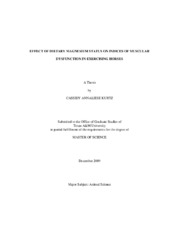| dc.description.abstract | Throughout the performance horse industry, the occurance of various muscle
disorders is common and can be detrimental to the performance and longevity of equine
athletes. Research has revealed effects of diet manipulation, exercise, and electrolyte
supplementation on the symptoms and occurrence of disorders like exertional
rhabdomyolysis (ER). However, there has been no investigation on effects of Mg on
muscle function in horses during exercise.
Six Quarter Horse mares were used to study the effects of varying levels of Mg
on indices of muscular dysfunction during a standardized exercise test (SET) on a highspeed
treadmill. Three rations were used over three 28 d periods: control (Trt 1), low Mg
(Trt 2), and high Mg (Trt 3). A baseline SET was conducted prior to day 0 (Trt 0).
Blood samples were taken during the SET at rest, immediately post, 1 h, 6 h, and 24 h
post exercise for analyses of serum muscle enzymes and Mg concentrations. Heart rates
(HR), respiration rates (RR), and rectal temperatures (RT) also were documented.
No effect of Trt was observed on HR or RR at any point throughout the SET.
Resting RT?s were lowest in Trt 0 (P<0.05). There was no Trt effect on blood lactate
(LA) during the SET; however, blood glucose (GLU) at rest in Trt 2 was lower than Trt
0 (P<0.05). Treatment had an effect on both resting serum creatine phosphokinase (CK),
as Trt 3 was higher than Trt 0, and the change in CK from rest to 24 h post SET, where
Trt 1 exhibited the greatest increase in CK concentration (P<0.05). Serum aspartate
aminotransferase (AST) and lactate dehydrogenase (LDH) were not affected by Trt
(P>0.05). Serum alkaline phosphatase (AP) at rest and 6 h post exercise was lower in
Trt 2 than in Trt 3 (P<0.05). Additionally, serum P was lowest at rest in Trt 0 and
highest 6 h post exercise in Trt 3, also varying within each Trt. Average daily intake
(ADI) of Mg was higher in Trt 1 and 3 than in Trt 2 (P<0.05). Finally, at rest,
immediately post and 24 h post exercise, serum Mg was highest in Trt 3 (P<0.05).
Results suggest there is an effect of dietary Mg on serum muscle enzyme and Mg
concentrations and potentially, overall performance in the equine athlete. | en |


